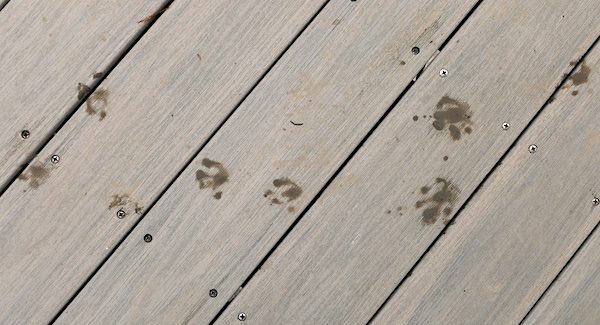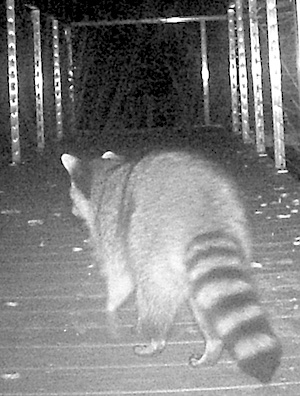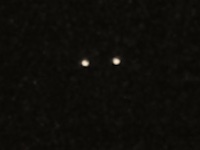Top Photo: Eyeshine from two raccoons about to climb up on the Floating Walkway in Explore the Wild.
It’s a well known fact that raccoons use the floating walkway in Explore the Wild to get around the wetlands, they leave tracks for me to find every night. Otters use the walkway as well. Besides their foot prints, otters also leave behind signage in the form of scat, usually on the rocks next to the walkway, or on the walkway itself.

Lately there’s been a jumble of foot prints on the walkway due to low water and exposed mud. Each morning there’s a new set of very muddy tracks, multiple tracks, left behind by late night foraging animals. Foraging for tadpoles and juvenile frogs can be rewarding this time of year, especially with the water as low as it has been. The low water concentrates the tadpoles into ever shrinking pools of water, easy pickins.
Some of the tracks are difficult to distinguish as to their originator. I could make out raccoon tracks and a few otter tracks but a trail camera might reveal more. So, I decided to place a camera on the walkway to see just who has been using the walkway during these nocturnal forays.



Exhibits Tech Dakota installed a camera in a heavily trafficked area. I decided to leave the camera up for a week and see what pops up. The camera was active each day during off hours, when the museum was closed to the public. After a few setbacks the camera worked fine and recorded raccoon after raccoon making its way across the walkway.



I’m not sure how many raccoons were out and about on any given night. Going over the numerous photos, it was no great surprise that each night had multiple raccoon images (three was the most seen at any given time in any one image). No other animals were seen, no otters, no opossums, fox or mink. The one exception was what looks like a gray catbird on one misty morning.

Conclusion: We have a healthy population of raccoons in and around our wetlands. And though no other animals (except the catbird) were seen during our brief observational period it doesn’t mean they don’t use the walkway. In fact, we know that otters are fairly regular visitors, mink and muskrat less so, even gray fox. Over the years, groundhogs have been observed in the wetlands. But raccoons are the regulars, the day to day, or night to night, blue-collar users. The wetland’s everyanimal.

Ranger Greg